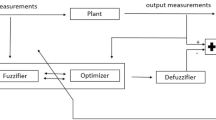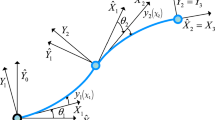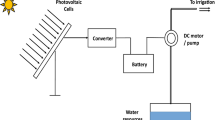Abstract
A neurofuzzy scheme has been designed to carry out on-line identification, with the aim of being used in an adaptive–predictive dynamic matrix control (DMC) of unconstrained nonlinear systems represented by a transfer function with varying parameters. This scheme supplies to the DMC controller the linear model and the nonlinear output predictions at each sample instant, and is composed of two blocks. The first one makes use of a fuzzy partition of the external variable universe of discourse, which smoothly commutes between several linear models. In the second block, a recurrent linear neuron with interpretable weights performs the identification of the models by means of supervised learning. The resulting identifier has several main advantages: interpretability, learning speed, and robustness against catastrophic forgetting. The proposed controller has been tested both on simulation and on a real laboratory plant, showing a good performance.









Similar content being viewed by others
References
Cutler CR, Ramaker BL (1980) Dynamic matrix control–a computer control algorithm. Proc JACC Joint Automatic Control Conference, San Francisco, USA, WP 5-B
Vandoren VJ (1998) Advanced control software goes beyond PID, Control Eng January pp 73–76
Chow CM, Kuznetsov AG, Clarke DW (1995) Using multiple models in predictive control. Proceedings of 3rd European Control Conference pp 1732–1737. Italy, September
Camacho EF, Bordons C (1999) Model predictive control in the process industry ed. Springer, London
Peterson T, Hernández E, Arkun Y, Schork F (1992) A nonlinear DMC algorithm and its application to a semibatch polymerization reactor, Chem Eng Sci, vol 47, pp 737–753
Ibarrola JJ, Sandoval JM, García-Sanz M, Pinzolas M (2002) Predictive control of a high temperature short time pasteurization plant. Cont Eng Pract 10(7):713–725
Lotfi AH, Anderson C, Tsoi AC (1996) Interpretation preservation of adaptive fuzzy inference systems. Int J Approxim Reasoning 15(4)
Setnes M, Babuska R, Kaymak U, Van Nauta Lemke HR, (1998) Similarity measures in fuzzy rule base simplification. IEEE Trans Syst, Man, Cybern Part B, 28:376–386
Jin Y (2000) Fuzzy modelling of high-dimensional systems: complexity reduction and interpretability improvement. IEEE Transact Fuzzy Syst 8(2):212–221
Grossberg S (1982) Studies of mind and brain: neural principles of learning, perception, development, cognition and motor control. Reidel, Boston
French RM (1999) Catastrophic forgetting in connectionist networks: Causes, consequences and solutions. Trends Cogn Sci 3:128–135
Chen S, Billings SA (1992) Neural networks for nonlinear dynamic system modelling and identification. Int J Control 56(2):319–346
Chen S, Billings SA, Grant PM (1990) Nonlinear system identification using neural networks. Int J Control 51:1191–1214
Narendra KS, Parthasarathy K (1990) Identification and control of dynamic systems using neural networks. IEEE Trans Neural Networks 1(2):4–27
Piché S, Sayyar-Rodsari B, Johnson D, Gerules M, (2000) Nonlinear model predictive control using neural networks. Control Syst Mag June 53–62
Tan Y, De Keyser R (1994) Neural networks based adaptive predictive control. In: Clarke D (ed) Advances in model-based predictive control. University Press, Oxford
Takagi T, Sugeno M (1985) Fuzzy identification of systems and its applications to modelling and control. IEEE T Syst Man Cyb 15:116–132
Johansen TA, Shorten R, Murray-Smith R (2000) On the interpretation and identification of dynamic Takagi-Sugeno fuzzy models. IEEE T Fuzzy Syst 8(3):297–313
Pedrycz W (1993) Fuzzy control and fuzzy systems. Research Studies Press Ltd
Galván JB, Pérez-Ilzarbe MJ (1994) Two neural networks for solving the linear system identification problem. Proc of the ICNN’94 5:3226–3231
Lera G, Pinzolas M (2002) Neighborhood based Levenberg-Marquardt algorithm for neural network training. IEEE Trans Neural Networks 13(5):1200–1204
Ibarrola JJ, Guillén JC, Sandoval JM, García-Sanz M (1998) Modelling of a high temperature short time pasteurization process. Food Control 9(5):267–277
Acknowledgements
We gratefully appreciate the support given by the Spanish Comisión Interministerial de Ciencia y Tecnología (CICYT) under grant 1DPI 2000 04150- P403.
Author information
Authors and Affiliations
Corresponding author
Rights and permissions
About this article
Cite this article
Ibarrola, J.J., Pinzolas, M. & Cano, J.M. A neurofuzzy scheme to on-line identification in an adaptive–predictive control. Neural Comput & Applic 15, 41–48 (2006). https://doi.org/10.1007/s00521-005-0006-x
Received:
Accepted:
Published:
Issue Date:
DOI: https://doi.org/10.1007/s00521-005-0006-x




